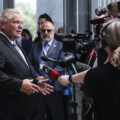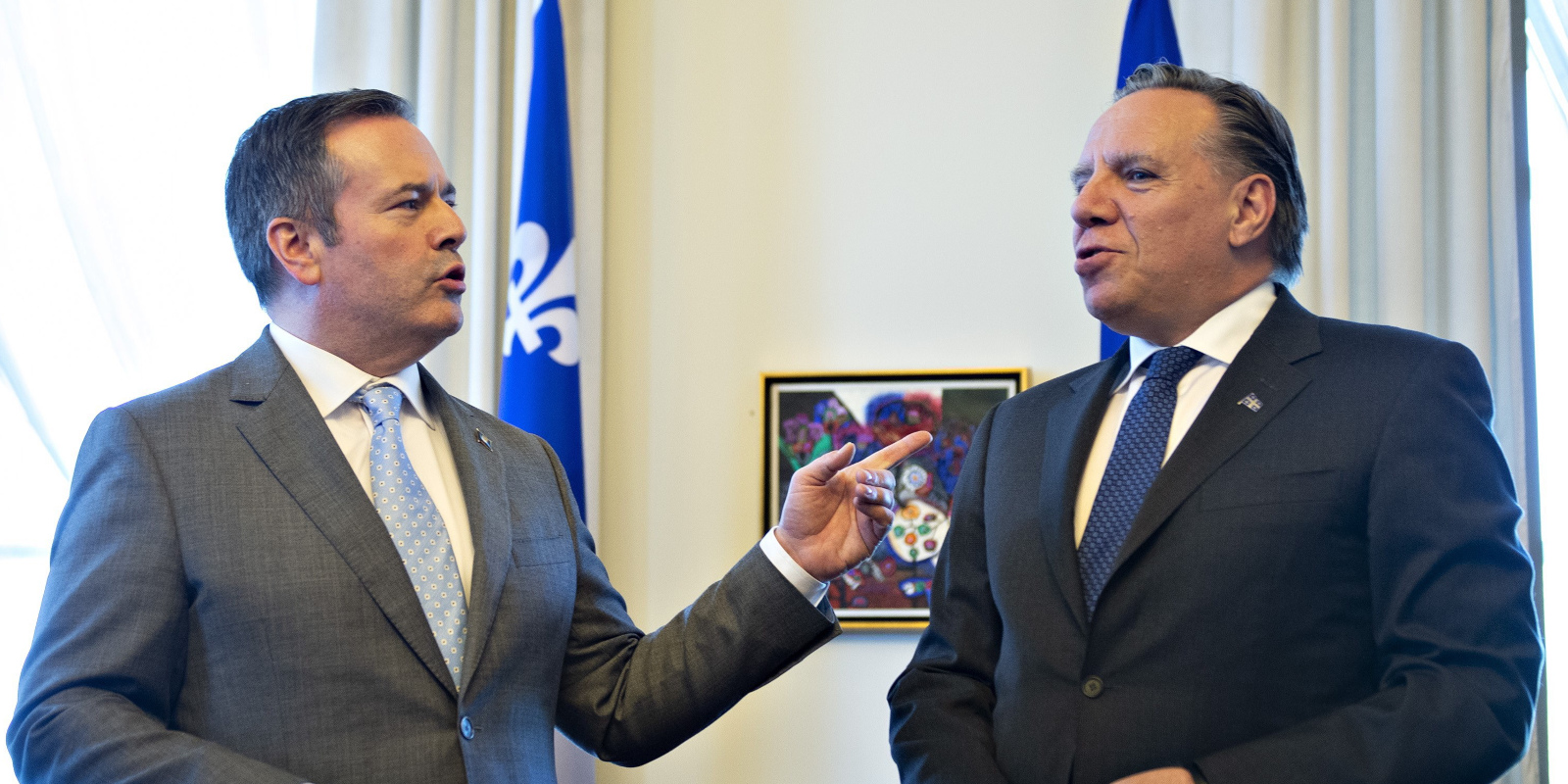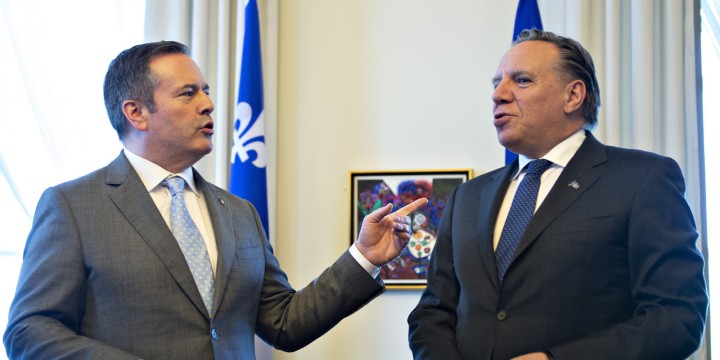In this Hub Dialogue, The Hub’s editor-at-large Sean Speer speaks to Ben Eisen, a policy expert, who has written extensively about the Equalization program.
This conversation has been revised and edited for length and clarity.
Sean Speer
Today’s Hub Dialogue is with Canadian policy expert Ben Eisen. Ben is an adjunct professor at Drexel University in Pennsylvania and a senior fellow in fiscal policy and provincial prosperity at the Fraser Institute. He has written extensively on the design, implementation and outcomes associated with the federal government’s Equalization program.
In light of the Alberta government’s referendum on equalization early next week, Ben is the perfect person to speak to in order to better understand some of the big policy questions underpinning the referendum.
Thanks for joining us, Ben, to share your expertise and insights on a complex subject.
Ben Eisen
Thanks for having me, Sean.
Sean Speer
One often hears policymakers or policy observers distinguish between small “e” equalization, which describes the principle of equalizing fiscal resources in a federal system, and big “E” Equalization, which describes the federal transfer program that aims to contribute to the goal of equalization across Canada’s provinces. Why don’t we start by having you discuss equalization as a general principle and as an actual federal program that is now subject to the Alberta referendum?
Ben Eisen
Well, we can start with the program itself, because that’s the easy part. The Equalization program is simply a federal program that takes revenues and redistributes them to lower-income provinces to help them deliver public services. In a nutshell, Equalization is designed to identify provinces that might have trouble raising their own revenues through different forms of provincial taxes, and essentially gives them a top-up from the federal government to help them pay for health, education, and other things that provinces pay for. That’s the specific Equalization program.
But some people talk about a broader notion of equalization, as sort of a bigger picture view that has to do with the fact that the various provinces have different net contributions to the federal government. Which is to say that if we take all the taxes that are paid from businesses and residents in a particular province versus all the federal services and transfers that come back into that province, there may be a net contribution or a net draw depending on a province’s circumstances. There’s usually a gap in every province one way or another, and in some provinces that gap is quite large.
Alberta, for instance, pays much more into the federal government in taxes from businesses and residents there than it gets back in the form of pensions and services. For lower-income provinces, such as New Brunswick or Quebec, by contrast, it’s quite the opposite for a number of reasons.
This notion of a broader equalization is amorphous: it means different things to different people based on which programs are included in the calculation or the timeframe that is covered and so on. But in a nutshell, I would say that’s what it is: it’s an understanding that goes beyond the actual Equalization program itself and views the net contribution or net draw of federal revenues and expenditures across the different provinces.
Sean Speer
As you say, the broader concept of equalization reflects various normative and political economy considerations. Let’s leave those issues aside and focus on the Equalization program which you’ve already talked about a bit.
Equalization is not something that’s negotiated between different orders of government but rather it’s a federal program for which Ottawa has unilateral responsibility on its design and implementation. Can you explain how the program works? How does the federal government calculate the eligibility and entitlement for different provinces in the Equalization program?
Ben Eisen
Well, people talk about it being very complicated sometimes, but it isn’t really. The fine details are quite complicated, but the big picture is relatively straightforward. Basically, what the federal government does is it looks at all of the provinces and then for each of the various categories of taxation (including income taxes, sales taxes, excise taxes, and so on), it imagines that all the provinces set their tax rates at the average level. Then the federal government asks, “How much money would you raise if you did this?” And of course, higher-income provinces would raise a lot of money, while lower-income provinces would not raise very much money.
Let’s say you’re a low-income province: it’s not going to be as easy to generate as much income tax revenues at a given level of taxation as it would be if you were a high-income province. This ability to generate revenue at average tax rates is what is referred to as fiscal capacity: the ability to raise money at the same level of tax across different provinces.
Having determined how much revenues the different provinces would generate – in effect, what each province’s fiscal capacity is – the federal government then provides a top-up to lower-income provinces that would have a hard time raising enough money to deliver adequate public services. These top-ups are the Equalization payments.
The Equalization program provides extra money to provinces with lower-than-average fiscal capacity to bring them up to the national average in order to allow them to help pay for public services at roughly national average levels of taxation. That’s the principle in short. It takes federal money which comes in from all over the country, from taxpayers and residents from coast to coast, and then it gives it back to the governments in lower-income provinces to help them pay for services beyond what they’d be able to pay for with raising their own tax revenues.
Sean Speer
As you explained, the reason that some provinces are recipients of Equalization payments and other provinces aren’t is due to this issue of fiscal capacity. This isn’t a static process though. It has a dynamic aspect to it based on changing economic conditions across the country. Can you just reflect on how provinces’ fiscal capacity might change over time?
Ben Eisen
It is dynamic, but it’s also somewhat slow moving. It’s based on a multi-year average, because the people who made the program’s design didn’t want single year blips or oddities in a province’s fiscal capacity in one way or another to dominate the very next year. So, there’s a three-year average, with more weight into the most recent year, and then there’s actually a lag in terms of when the first year is used. So, while you’re right that it’s dynamic – it’s meant to capture ongoing changes in the relative fiscal capacity of the different provinces – it can take a while for large but durable changes to make their way into the formula and hence it can take a while for the program to catch up. In other words, the Equalization can be somewhat slow moving in its adjustment to changes in fiscal capacity.
Sean Speer
In an earlier answer, you observed that the Equalization formula accounts for a province’s revenue-generating capacity across multiple forms of taxation. Do you want to elaborate on the various inputs? Do income taxes have the biggest effects on determining a province’s fiscal capacity?
Ben Eisen
On the tax side, yes, income tax revenues are a primary determinant of fiscal capacity.
But natural resource revenues are also a huge determinant in the fiscal capacity of various provinces. Because natural resource prices can be so volatile, natural resources revenues bounce around a lot more than tax revenues. They create changes in the level of fiscal capacity far faster than changes in tax revenues. So, for instance, you have a situation in Newfoundland and Labrador that saw its natural resource revenues absolutely go through the roof in relatively recent history, and that changed the province’s overall fiscal capacity dramatically.
Sean Speer
An obvious question in light of the Alberta referendum is what, if any, changes to Equalization would produce different outcomes? Or given that the formula is based on a three-year average and a lot of trends with respect to income levels in the provinces are relatively durable, is there something resembling the status quo essentially baked into the system?
Ben Eisen
Well, that really just depends on how creative you’re willing to be with the formula. The notion of equalization payments is in the Constitution, but there is very little guidance on what that means. And so, if you’re willing to be creative with the formula, you could get all kinds of different results that are completely different than the distribution of payments that we currently have.
Let me give one extreme example: the program could be changed so that instead of our low-income provinces being equalized to a national average, there’s no reason that the formula couldn’t say that fiscal capacity for all of the provinces had to be equalized to the level of the province with the highest fiscal capacity. So, if you want it to do that and remove other rules, such as ones limiting the overall size of the Equalization program, you can say that every province, except Alberta, gets equalization so that they’re leveled up to Alberta’s level of fiscal capacity. That would obviously be a massive change to who gets Equalization payments and how much they receive.
To use a more realistic example, if you decided that you wanted to completely exclude natural resource revenues from the Equalization formula, which some people have called for, you would get a big distributional change from province to province amongst the current so-called “have nots.” You would see Quebec, which has significant natural resource revenues, get more of the pie, and the other smaller provinces that have less natural resource revenues, like the Maritimes, would get less.
The key point though is that the formula isn’t set in stone in a way that requires outcomes similar to the ones we have now. You could make big changes that would produce very different distributions, both in terms of who gets money and how much they get. Most of the typical ideas for reform are sort of close to around the edges and don’t necessarily involve huge changes, but in theory there’s nothing stopping policymakers from enacting big changes with big impacts.
Sean Speer
What’s both explicit and implicit in your response is the role that the cap on the growth of the Equalization program has played in contributing to some of these zero-sum questions. Can you just elaborate on what it means to cap the Equalization program? What was the rationale for capping it and what have been the implications for the current policy debate?
Ben Eisen
This all began way back towards the end of the first decade of this century, when the writing on the wall was that Ontario was very likely to become a “have-not” province and simultaneously there was a gap opening up between richer and poorer provinces due in large part to high energy prices. The result of these two trends is we were seeing significant and rapid increases to Equalization payments, while at the same time the federal government was trying to reduce its budget deficit.
The federal government was looking at the potential for fast-rising costs from Equalization payments to Ontario and decided to take action to prevent the program from growing even more expensive. So, what they essentially did was take the level of Equalization at that time, and say, “This is going to grow in line with national GDP in the future.” This set the growth of the Equalization program as a share of GDP. Unless it is changed, it won’t grow any faster than changes in overall economic activity.
What happened in the subsequent years is that this change – the creation of a cap on the Equalization program – did exactly what it was supposed to do. Payments were capped and didn’t go higher as it would have without this new rule. So, that program stopped growing as quickly as it had in the years before.
To the question of why the cap was initially put in place, it’s relatively simple. The federal government was worried about rising costs. Every program has objectives as goals, it has concerns as limitations, and costs are always a factor that governments have to consider. The cap was set to manage costs.
Yet something interesting and unexpected happened after that. The gap between rich and poor provinces started to shrink, and the fiscal capacity and fixed growth rate rule of Equalization has started to interact in a funny and unusual way.
In terms of fiscal capacity, provinces actually came closer together when the natural resource revenues in resource-rich provinces were struggling. What happened then is this fixed-growth rate rule, which was meant to cap costs, started doing the opposite. It started acting as a floor on costs. What we’re having now is that the federal government, because of this rule, making awkward adjustments to the payments of Equalization-receiving provinces that are larger than would have been the case if they had never made this rule change. It’s an interesting case about how the fixed growth rate rule was created out of a desire to prevent costs from escalating, and now it’s having the exact opposite effect and is actually pushing costs up.
Sean Speer
We spent today’s conversation talking about the Equalization program, but of course, it’s only one piece of the broader system of fiscal federalism that we have in the country between Ottawa, the provinces, and municipalities. What would you say to the argument that what we need, for various reasons, including growing concerns about the fiscal sustainability of the provinces, is a deeper and much more comprehensive set of reforms to our system of fiscal federalism?
Ben Eisen
Well, to start, we should always be examining our approach to fiscal federalism. It’s so important in a country like Canada, that is a federation with provinces that have very different levels of income and very different conceptions of their interests and goals, to always keep an eye on fiscal federalism. It’s a potential source of friction or harmony, depending on whether we get it right or wrong. So, we should always be looking at it options for improvement.
In terms of whether this moment specifically calls for re-examination or a careful look at fiscal federalism, there’s lots of ways in which it is a good time to take a look at how well these systems are functioning and how well our federation is working. Particularly right now, when we have a system in which the federal government collects so much more money than it needs to meet its own responsibilities, and where the provinces don’t collect enough.
We have this system of very large transfers on a per capita basis going from the federal government to the provinces to help them pay for services. This creates all kinds of problems for accountability: nobody knows whose fault it is if services go wrong, whether the provinces have done something wrong, or whether the federal government simply isn’t providing enough money for health care and things of that nature. That is a very good case to be made for trying to address that, or trying to reduce federal taxes, and give the provinces the ability to raise money of their own to help generate own source revenue to pay for their own services, so that we don’t have these big transfers from place-to-place which blur accountability.
That’s just one example, but more broadly, we should start from the premise that nothing is perfect. Our system of fiscal federalism is far from perfect, and we should always be taking a careful look at how we can make things better. In that respect, now is no different than any other time. We should not become complacent, because the extent to which our provinces have harmony and shared purpose is good for the country, and to the extent to which there’s acrimony and disagreement about fairness, the worse things are. It’s always something to keep our eyes on and now is no different than any other time in that respect.
Sean Speer
Thanks for sharing your insights and expertise on what is a complex and yet highly salient topic. We’re grateful to have you join us today.
Ben Eisen
My pleasure Sean.
Recommended for You

Ginny Roth: J.D. Vance, Pierre Poilievre, and how they slice their economic pie

David Polansky: As President Biden leaves the race, will the Democratic Party hodgepodge hold?

Trevor Tombe: Canadians are paying billions in hidden taxes on new homes

Stephen Staley: Widespread deregulation is Canada’s golden ticket for economic growth



